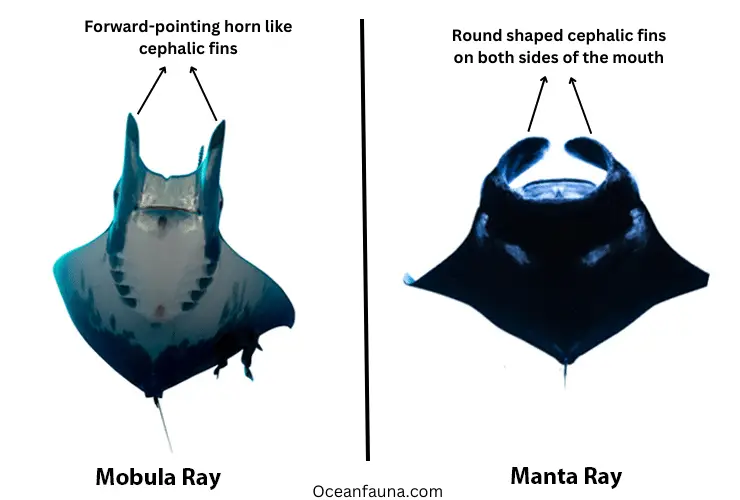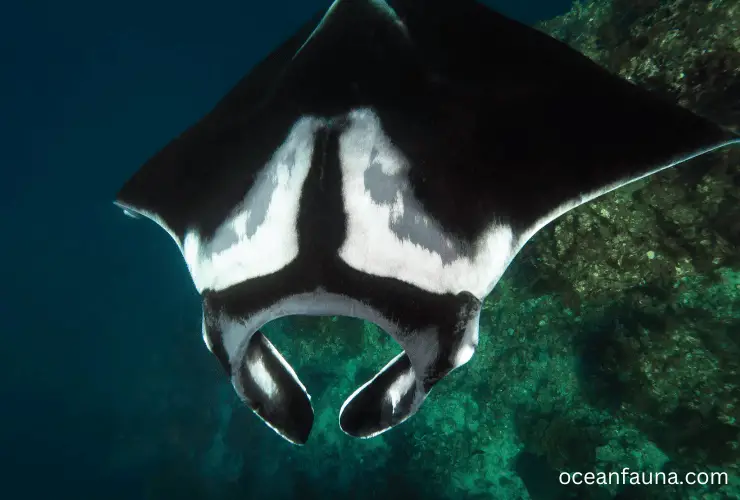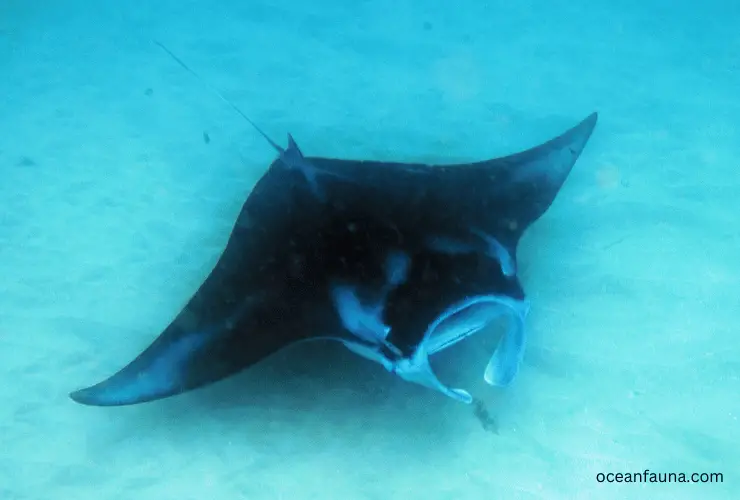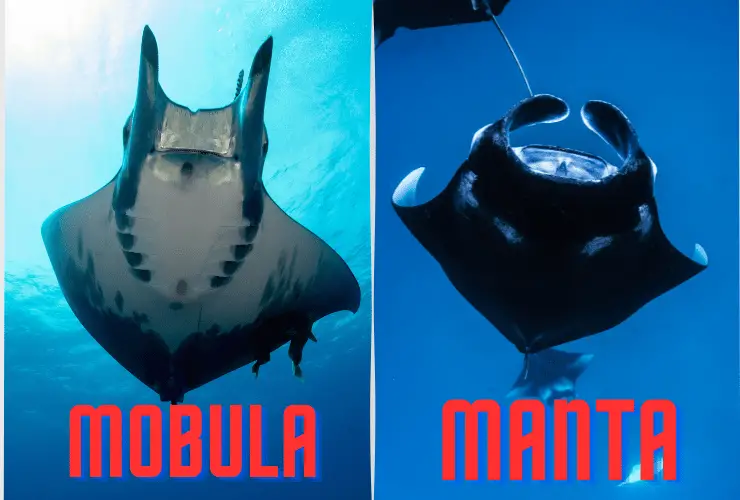Manta rays and Mobula rays are often confused with one another due to their similar appearance, but there are distinct differences between these two species.
Manta rays belong to the genus Manta, while mobula rays belong to the genus Mobula. Although both species are members of the same family (Mobulidae), their size, behaviour, and geographical distribution have several differences.
This blog will explore these differences in detail and provide a comprehensive guide to understanding the key differences between manta rays and mobula rays.
Whether you are a marine biologist, ocean enthusiast, or just curious about these fascinating creatures, this guide will provide you with all the information you need to differentiate between manta rays and mobula rays.
Comparison Between Mobula Ray and Manta Ray
| Feature | Manta Ray | Mobula Ray |
| Appearance | Broad heads with triangular pectoral fins. Horn shaped cephalic fins on both sides of the mouth and Ventral gill openings. | Sharper than a Manta. Forward-pointing horn like cephalic fins, or slender heads. |
| Size | Up to 23ft. | Up to 17ft. |
| Taxonomy | Genus: Mobula Rafinesque | Genus: Manta |
| Diet | Manta rays consume planktonic crabs, shrimp, and krill for food. | Mobula Rays consume small schooling fish and planktonic crustaceans. |
| Weight | Upto 5,300 lbs. | Upto 3,500 lbs. |
| Distribution | Found primarily in deep coastal waters. The Mediterranean Sea is where they are most common, but they can also be found in the Eastern Atlantic Ocean, especially off the coasts of Ireland and Portugal on the southwest and northwest, respectively. | They are common in the open ocean or on reefs near the shore. From North Carolina to northern New Zealand, you can find them. In general, they prefer cold, subtropical, and tropical waters. |
| Lifespan | 40 years. | 15 to 25 years. |
| Mouth Location | Very front of the head, between the cephalic wings. | Underside of its head. |
Key Differences Between Mobula and Manta Ray
1. Shape and Size
Mobula rays and manta rays are both members of the same family, Mobulidae, and are similar in appearance. However, there are some noticeable differences in their shape and size.

Manta rays are generally larger than mobula rays, with a wingspan of up to 23 feet, while mobula rays typically have a wingspan of around 10 feet.
Manta rays have a more triangular-shaped body with long, pointed cephalic fins extending forward, giving them a distinctive “T” shape. Mobula rays, on the other hand, have a more circular body shape and shorter, rounded cephalic fins.
Another difference is the presence of a protruding snout or rostrum on the mobula ray, which is absent in the manta ray. The tail of a mobula ray is also typically longer and more pointed than that of a manta ray.
While both mobula and manta rays share many similarities, their distinct shapes and sizes make them easy to differentiate from each other.
2. Mouth Location
Even though both creatures are closely related, they do have some differences in their morphology, including the location of their mouths.

Manta rays have a large, broad head and a wide, rectangular mouth that is located at the front of their head, between their two cephalic fins.
This mouth position allows manta rays to easily filter large volumes of plankton-rich water as they swim forward, using their gill rakers to strain out small prey.
In contrast, mobula rays have a slenderer head and a smaller, more pointed mouth that is located closer to the front of their head, just below the cephalic fins.
This location allows mobula rays to more precisely target smaller prey items, such as small fish or crustaceans and to feed more selectively.
Overall, while both manta and mobula rays are filter feeders, their differences in mouth location suggest that they may have slightly different feeding strategies and prey preferences.
3. Number of Gills
Both manta and mobula rays have five pairs of gill slits located on the underside of their bodies, behind their respective cephalic fins. These gill slits are used to extract oxygen from the water as it flows over the gill filaments.

While manta and mobula rays have the same number of gill slits, they may differ in the size and shape of their gills, which could affect their respiratory efficiency.
For example, manta rays are known for their large, paddle-like cephalic fins that they use to direct water over their gills. On the other hand, mobula rays have smaller, more pointed fins that may be less effective at directing water flow.
In general, manta and mobula rays have evolved specialized respiratory structures that allow them to extract oxygen from the water efficiently, despite their aquatic environment’s relatively low oxygen content.
4. Color
Manta and mobula rays can vary in coloration, but both types typically have a dark upper surface and a lighter underside.
The shade and pattern of coloration vary among individuals and may be influenced by factors such as age, sex, and location.
One potential difference in coloration between manta rays and mobula rays is that they may have more distinct markings on their backs. In contrast, mobula rays may have a more uniform, solid coloration.
For example, some species of manta rays have a distinctive pattern of white spots or markings on their dorsal surface, which can be used to identify individuals.
However, it’s important to note that there is a lot of variation in color and markings within the manta and mobula ray groups, and it can be challenging to distinguish between them based on color alone.
5. Behavior
Manta rays are generally considered to be more docile and less active swimmers than mobula rays. They are known for their curious and playful behavior and are sometimes observed approaching divers or boats.
Manta rays also have a distinctive swimming style, where they flap their wings in a slow and graceful motion, allowing them to glide through the water with minimal effort.

In contrast, mobula rays are more active and acrobatic swimmers and are known for their ability to leap out of the water, sometimes reaching heights of several meters.
This behavior is thought to be a form of communication and a means of evading predators or dislodging parasites.
6. Habitat
Manta rays are found in tropical and subtropical waters around the world, including the Atlantic, Pacific, and Indian Oceans. They prefer open water habitats and are often found in areas with strong currents and upwelling, where their food sources are concentrated.
Mobula rays, on the other hand, are found in coastal and offshore waters in the world’s oceans, including the Atlantic, Pacific, and Indian Oceans. They tend to be more common in temperate and tropical waters and are often found in areas with high levels of primary productivity, such as upwelling zones or near the mouths of rivers.
Both manta rays and mobula rays are migratory species, and their distributions can vary seasonally and regionally. However, they are generally more common in warmer waters and areas with high planktonic food sources.
7. Consumption
Manta rays and mobula rays are both filter feeders, meaning they consume plankton and small fish by filtering them out of the water. However, there are some differences in their consumption patterns.

Manta rays tend to feed on plankton, small fish, and other invertebrates, primarily in open-water habitats such as the oceanic pelagic zone. They use their cephalic fins, which are modified into a funnel-like structure, to direct water into their mouths and over their gills, where they filter out food particles.
Mobula rays, on the other hand, tend to feed on smaller plankton and fish species and are more commonly found in coastal waters. They also use their cephalic fins to filter feed, but they tend to be more active swimmers than manta rays and may take in larger quantities of prey.
8. Species
There are two recognized species of manta rays in the genus Manta. These species are the giant manta ray (Manta birostris), which can reach a wingspan of up to 29 feet, and the reef manta ray (Manta alfredi), which is smaller and typically has a wingspan of up to 16 feet.
These graceful filter-feeders are found in tropical and subtropical waters around the world and are known for their distinctive triangular-shaped bodies and graceful swimming style. While manta rays are generally not considered dangerous to humans.
On the other hand, there are nine recognized species of mobula rays in the genus Mobula, which is a group of filter-feeding rays closely related to manta rays.
These species vary in size and distribution, but are generally smaller and more compact in shape than manta rays.
They are found in both tropical and temperate waters around the world and are known for their acrobatic jumps out of the water.
Some of the most well-known species of mobula rays are as follows.
- The giant devil ray (Mobula mobular), which can reach a wingspan of up to 5 meters, and
- The reef mobula (Mobula alfredi), which is smaller and commonly found in shallow waters around coral reefs.
The pygmy devil ray (Mobula eregoodootenkee) is another interesting species, as it is the smallest of the mobulid rays.
FAQs
Can You Swim with Mobula Rays?
Swimming with mobula rays can be a memorable and exciting experience, but it is important to approach these animals with respect and caution.
Mobula rays are generally not considered dangerous to humans and are typically very docile, but like all wild animals, they should be treated with care and not disturbed or provoked.
How Long Do Mobulas Live For?
The lifespan of mobula rays can vary depending on the species, but generally, they can live up to 15 to 25 years in the wild. However, more research is needed to determine all species of mobula rays’ lifespan accurately.
How And Why Do Mobulas Fly?
Mobula rays, also known as devil rays, are able to “fly” out of the water and glide through the air for several seconds. They do this by gaining enough speed underwater, then breaking the surface and using their pectoral fins to generate lift and stay airborne.
Are Mobulas Dangerous?
No, mobula rays are generally not considered dangerous to humans. They are a type of ray that belong to the same family as manta rays and are known for their acrobatic jumps out of the water.
While they have a spine on their tail that could cause injury if stepped on or grabbed, they are not aggressive toward humans and are typically very docile.
However, like all wild animals, it is important to treat them respectfully and maintain a safe distance to avoid accidentally startling or disturbing them.
Conclusion
Mobula rays are sometimes called devil rays because of the distinctive shape of their pectoral fins, which resemble horns or wings. These large, triangular-shaped fins extend from the sides of their bodies and give them a unique and often intimidating appearance.
The name “devil ray” is also thought to come from the rays’ acrobatic jumps and flips out of the water, which may have been seen as devilish or otherworldly by some people.
Additionally, the name may be related to historical beliefs and superstitions about the devil and his association with the ocean and sea creatures.
Sources used:
https://kids.nationalgeographic.com/animals/fish/facts/mobula-ray
https://www.floridamuseum.ufl.edu/discover-fish/species-profiles/mobula-hypostoma/
https://www.cabo-adventures.com/en/blog/mobula-ray-facts
https://www.youtube.com/results?search_query=are+devil+ray+and+mobula+ray+same%3F

